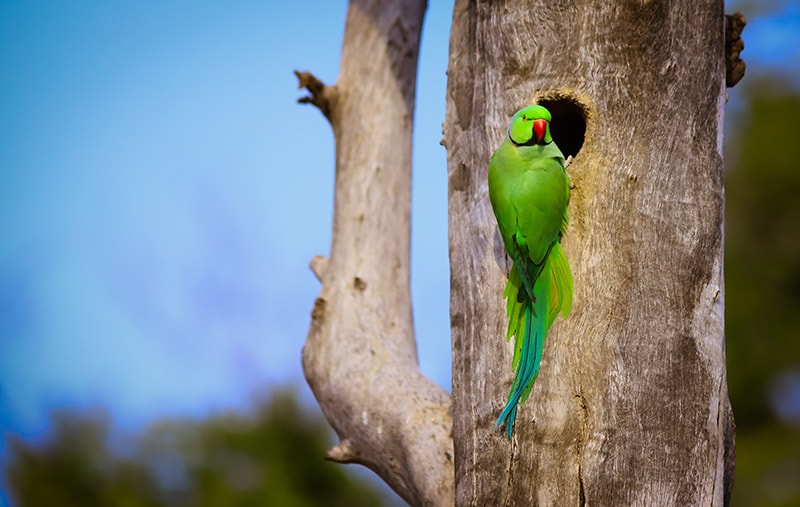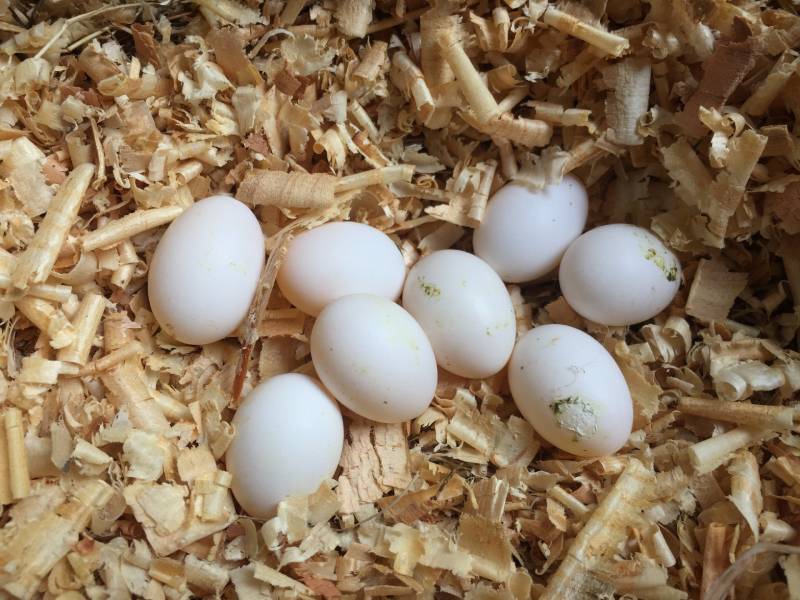How Many Eggs Do Parakeets Lay? Facts & FAQ (Vet Answer)

Updated on

Parakeets make great pets. They’re lively, friendly, intelligent birds. While most owners avoid breeding their birds because of the commitment required to raise the chicks and keep the birds, they can be quite easy to successfully breed given the right conditions.
Typically, it takes around 2 weeks for the female to start laying eggs after successful mating. The most popular parakeet kept as a pet, the rose-ringed parakeet (Psittacula krameri), will have a clutch of between one to seven eggs and will usually lay one each day. Both the male and female will sit on the eggs to incubate them, and they will start once the first two or three eggs have been laid. The eggs will hatch after approximately 3 weeks.
Breeding Parakeets
Parakeets do make great pets, but they have a life expectancy of up to 30 years when well cared for. They are also commonly found in pet stores and there are a lot of professional breeders supplying stores and individuals.
As such, breeding parakeets is unlikely to make you any money, especially once you factor in the costs of caring for the young and the mother before the young birds are sold.
If you have extra cages, space, and time to dedicate to a family of young parakeets, it can be very rewarding to breed these sweet birds. If you won’t be able to care for any young, or you don’t have homes for them, it is best to avoid breeding.

How Long Does It Take for Parakeet Eggs to Hatch?
Once the eggs are laid, it takes, on average, 18 days for the eggs to hatch and the hatching process will take 2 or 3 days to complete. Any eggs left after 3 weeks are usually infertile and can be removed. The mother won’t typically fret over the removal of an infertile egg, and it should be easy to retrieve.
Once the chicks have hatched, they should be left with the mother until they are at least 8 weeks of age and ideally 10 weeks. In the wild, babies would remain with their mothers until they are 6 months, but it is considered safe for pet parakeets to be separated at 8–10 weeks.
Tips to Ensure Successful Breeding
1. Choose a Breeding Pair Carefully
If you have several parakeets of your own, you may be able to choose a breeding pair from your own stock. However, you shouldn’t breed related Parakeets because this can lead to deformed or stillborn chicks. Alternatively, if you know other parakeet keepers, ask if you can introduce their birds for the purposes of breeding.

2. Prepare a Nesting Box
The female will need a nesting box. Parakeets don’t need nesting material because they don’t create nests in this way. But the box should be dark and contain a tray that mom can lay her eggs in. Ideally, the box should have a screen that you can remove to periodically check on the chicks.
3. Offer Fresh Vegetables and Softwood
Continue to feed your birds as normal, but consider offering additional fresh vegetables. Alternatively, you can get specialist pellets that help encourage breeding and keep the birds healthy during the mating process. Offer safe softwood for the female to chew.

4. Look for Signs of Nesting
There are some physiological signs of successful mating. The female’s cerne will become inflamed and form a crust, for example. But a surefire way of identifying successful mating is when you notice the female starting to nest. She will start to rearrange items and may take some material in the nesting box.
5. Chick Development Does Vary
You should leave the mother to incubate the eggs naturally and don’t disturb her during the incubation period. When the chicks are born, you can carefully check on them daily, but only visually. Remove the nesting box screen and make sure none are being smothered and that there are signs that the chicks are all eating.
There may have been a two- or three-day period of egg laying, which means that the chicks can be of different sizes and at different stages of development.

How Many Times Do Parakeets Breed in a Year?
Parakeets will naturally lay eggs once a year, during the spring. While they can be artificially encouraged to lay more often, it isn’t recommended.
What Is the Best Age to Breed Parakeets?
You should wait until parakeets are at least 12 months of age before breeding, and most will breed until they are 4 years old. Some may continue to breed after this time, but it isn’t considered ideal. Clutches will get smaller, and there are greater risks of complications.
When your parakeets reach about 4 weeks of age, you can sex them by looking at their ceres. This is the nose and nostril area. Males have blue ceres while females have brown.
Conclusion
Parakeets make good pet birds, and breeding them is quite easy as long as you have the right setup. You should only consider breeding them if you have homes arranged or have the room to keep the extra birds, however. Mating season is usually in spring, and mom will lay her eggs about 2 weeks after successful mating.
She will have a clutch of between four and eight eggs and they will hatch after 18 to 21 days. Any that have not hatched after 3 weeks are likely to be infertile and can be removed.
Featured Image Credit: Tahir_1, Shutterstock














